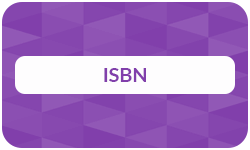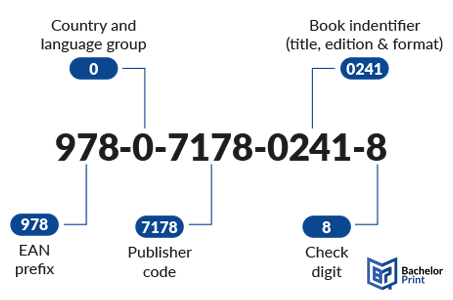
When exploring printing terms, one of the most essential yet often overlooked is the ISBN. Short for International Standard Book Number, it is the unique identifier that makes every book in the world easy to find, catalogue, and sell. It ensures there is no confusion between different versions of the same work. Knowing what an ISBN is and when you need one is essential for anyone dealing with book printing or publishing.
Definition: ISBN
An ISBN (International Standard Book Number) is a unique, standardized number used to identify books. Each ISBN points to one specific title, edition, and format, making it easy for bookstores, libraries, and online platforms to organise and find the correct version. In short, the ISBN is like a fingerprint for books.
History
The ISBN was introduced in 1970 as an international standard (ISO 2108) to simplify book identification worldwide. It evolved from a British system called the SBN (Standard Book Number) and quickly became the global reference for publishers, libraries, and booksellers.
In 2007, the system expanded from 10 digits to the current 13-digit format to allow more capacity and align with worldwide barcode standards.
Copy and print from £0.08
- High-quality copies & prints for any project
- Vibrant color prints or sharp black & white prints
- Online copy and print services delivered straight to your door
Learn more!
Relevance
The ISBN allows bookstores, libraries, and online shops to catalogue and track titles accurately, ensuring the right edition is always available. For authors and publishers, an ISBN is often mandatory for selling on platforms like Amazon or Barnes & Noble.
Note: An ISBN is not the same as a barcode. The ISBN identifies the book itself, while the barcode is a scannable version used in retail systems. In practice, the two work together: ISBN provides the data, and the barcode makes it usable at the checkout.
Structure
Modern ISBNs use a 13-digit format, while older books may still carry the shorter 10-digit ISBN. Both serve the same purpose, but the shift to 13 digits in 2007 aligned the system with international barcode standards and expanded its capacity.
ISBN-10 vs. ISBN-13
ISBN-10
Used until 2006, shorter but now outdated.
ISBN-13
Current standard, compatible with EAN barcodes.
➜ Conversion is possible, but ISBN-13 is now the universal format.
Breakdown
Every ISBN has a clear structure, with each part carrying a specific meaning. Here’s how an ISBN-13 is built:
EAN prefix
Shows the prefix range; usually 978 or 979 (newer, added when 978 numbers ran low)
Registration group
Identifies the country or language area
Publisher code
Points to the publisher or imprint
Book identifier
Specifies the title, edition, or format
Check digit
Final number, calculated automatically to prevent errors

Why is a check digit necessary?
The check digit is the last number in an ISBN. It’s calculated from the other digits to make sure the ISBN is valid. Without the check digit, ISBN systems couldn’t quickly detect mistakes in book numbers.
- ISBN-13: The computer takes the first 12 numbers, runs them through a simple formula, and then picks the final digit (0–9) that makes the whole number “fit.”
- ISBN-10: The concept is the same, but it uses a different calculation method. However, if the correct value is 10, the check digit is shown as X.
ISBN vs. ISSN vs. DOI
In publishing, it’s easy to confuse different identification systems. While they look similar, each one serves a specific purpose:
- ISBN (=International Standard Book Number) is for books.
- ISSN (=International Standard Serial Number) is for journals and other serial publications.
- DOI (=Digital Object Identifier) is for digital scientific articles and online publications.
Identifier
Example
Purpose
ISBN
978-0-7178-0241-8
Identifies a specific book edition/format
ISSN
ISSN 1234-5679
Identifies a periodical title, not individual issues
DOI
10.1000/xyz123
Provides a permanent digital link to an article
➜ In short: ISBN for books, ISSN for periodicals, and DOI for research articles.
How to get an ISBN
ISBNs are issued by national ISBN agencies, and the process varies depending on the country:
- In the USA, ISBNs are sold through Bowker.
- In the UK and Ireland, Nielsen manages them.
- Some countries provide ISBNs free of charge (e.g., Canada).
➜ ISBN prices range widely depending on the country.
Is it always necessary?
An ISBN is not required in every case. It depends on what you plan to do with your book:
If you are printing a thesis, dissertation, or personal copies for friends, family, or internal use, you don’t need an ISBN. These copies won’t enter the commercial book trade.
If you want to sell your book through bookstores, online shops (Amazon, Barnes & Noble), or place it in libraries, an ISBN is essential. Retailers and cataloguing systems rely on it.
Services like Amazon KDP or IngramSpark can assign a free ISBN if you don’t purchase your own. The catch is that the platform is listed as the publisher, not you. You also cannot use that ISBN with another printer or distributor. If you want to retain full publishing rights and flexibility, it’s better to buy your own ISBN.
Different languages & editions
Each new version of a book requires its own ISBN. One ISBN cannot cover every format or translation.
-
Different languages:
A German translation and an English edition of the same book must each have its own ISBN. -
Different formats:
Paperback, hardcover, ebook, and audiobook versions of the same title each need separate ISBNs. -
New editions:
If you release a revised or updated edition with substantial changes, it must also receive a new ISBN.
➜ Minor corrections (like fixing typos or reprints with no changes) do not require a new ISBN.
Dissertation or thesis printing and binding
- Fast production & express delivery to meet your deadline
- Professional thesis & dissertation printing & binding services
- Premium materials, hard & soft bindings for a lasting impression
Learn more!
How to find or check an ISBN
Finding or verifying an ISBN is straightforward. You can:
- Search ISBN databases such as ISBN International or ISBNsearch.
- Use free lookup tools offered by online retailers or library catalogs.
- Check the book itself because almost every book lists its ISBN in one or more places.
If you need the ISBN for a citation, our article about how to cite a book might be useful:
Or if you’d like to see how a book citation looks in a specific style, take a look at these articles:
Placement in the book
An ISBN is usually printed in the following locations:
- Copyright page (shown as plain text)
- Back cover (often above the barcode)
- Dust anorak (sometimes printed inside or on the flap)
- Ebook metadata (embedded in the digital file so stores and devices can catalogue it)
➜ If you can’t find an ISBN on the book itself, searching an ISBN database with the title and author is the quickest way to track it down.
FAQs
An ISBN (International Standard Book Number) is a unique 13-digit code that identifies a specific book, edition, and format. It works like a fingerprint for books, making them easy to catalogue and sell worldwide.
The correct term is simply ISBN, since the “N” already stands for number. However, many people say “ISBN number,” and that’s fine in everyday use.
The price depends on the country. Prices for a single ISBN:
- USA: $125
- UK: £89
- Australia AU$44
- Canada: Free
Not always. ISBNs are required for books sold commercially through retailers, libraries, and distributors. If you’re only printing private copies (like a thesis or family history), you don’t need one.
You purchase or request one from your national ISBN agency. For example, Bowker in the U.S., Nielsen in the U.K., Thorpe-Bowker in Australia, and Library and Archives Canada. After registering, you receive your ISBN and assign it to your book’s details (title, author, format).